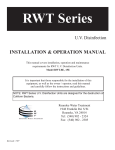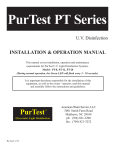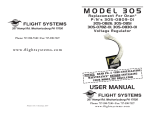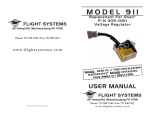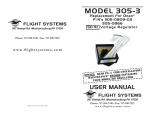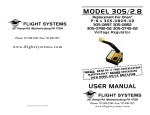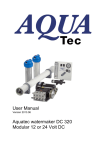Download Environmental Water Systems DWS-UV Troubleshooting guide
Transcript
DWS/SE/DWSW Series U.V. Disinfection INSTALLATION & OPERATION MANUAL This manual covers installation, operation and maintenance requirements for DWS/SE/DWSW U.V. Disinfection Units. Models DWS-7, 15, and SE-7, 15, and DWSW-8, 15. It is important that those responsible for the installation of this equipment, as well as the owner / operator, read this manual and carefully follow the instructions and guidelines. AQUA TREATMENT SERVICE, INC. 194 HEMPT ROAD MECHANICSBURG, PA 17050 ph: (717) 697-4998 fax: (717) 697-5035 Revised: 8/08 SAFETY INSTRUCTIONS WARNING - to guard against injury, basic safety precautions should be observed, including the following: 1. 2. 3. 4. 5. 6. 7. 8. 9. 10. READ AND FOLLOW ALL SAFETY INSTRUCTIONS. DANGER -To avoid possible electric shock, special care should be taken since water is present near electrical equipment. Unless a situation is encountered that is explicitly addressed by the provided maintenance and troubleshooting sections, do not attempt repairs yourself, refer to an authorized service facility. Carefully examine the disinfection system after installation. It should not be plugged in if there is water on parts not intended to be wet. Do not operate the disinfection system if it has a damaged power cord or plug, if it is malfunctioning or if it is dropped or damaged in any manner. Always disconnect water flow and unplug the disinfection system before performing cleaning or maintenance activities. Never yank the power cord to remove it from an outlet, grasp the plug and pull to disconnect. Do not use this disinfection system for other than the intended use (potable water applications). The use of attachments not approved, recommended or sold by the manufacturer / distributor may cause an unsafe condition. Intended for indoor use. Do not install this disinfection system where it will be exposed to the weather. Do not store this disinfection system where it will be exposed to temperatures below freezing unless all the water has been drained from it and the water supply has been disconnected. Read and observe all the important notices and warnings on the water disinfection system. If an extension cord is necessary, a cord with a proper rating should be used. A cord rated for less Amperes or Watts than the disinfection system rating may over heat. Care should be taken to arrange the cord so that it will not be tripped over or accidentally pulled from the outlet. SAVE THESE INSTRUCTIONS. WARNING: The light given off by this unit can cause serious burns to unprotected eyes and skin. Never look directly at a lit UV lamp. When performing any work on the UV Disinfection System, always unplug the unit first. Never operate the UV system while the lamp is outside of the UV chamber. WARNING: The UV lamp inside of the disinfection system is rated at an effective life of approximately 9,000 hours. To ensure continuous water treatment, replace the UV lamp annually with the appropriate Aqua Treatment Services UV lamp. Failure to comply may present a fire hazard. FUNCTION: The function of this ultraviolet disinfection unit is to provide in excess of 99% reduction of all water borne pathogenic (disease causing) bacteria. Model DWS/SE/DWSW series have a number code designation correspondent to the maximum gpm (gallons per minute) flow rate of the unit. I.E.- DWS-7 has a maximum flow capacity of 7 gpm. Applications: Ultraviolet Germicidal Disinfection A.T.S. Ultraviolet Disinfection Units are designed to destroy micro-organisms in water supplies. The Ultraviolet lamp peak radiation of 254 nanometer wavelength (nm) destroys or inactivates the D.N.A. (deoxyribonucleic acid) which absorbs the Ultraviolet radiation. A.T.S. Germicidal Disinfection units meet minimum dosages of 30,000 microwatt second per square centimeter. MAXIMUM CONCENTRATION LEVELS BEFORE ULTRAVIOLET: Turbidity.................................5NTU Color.......................................None Manganese........................0.05 ppm Hardness..........................................7 gpg Iron...................................................0.3 ppm pH....................................................6.5 - 9.5ppm Important Note - Pre-filtration equipment may be required if these parameters cannot be maintained. Flow rate must not exceed rated capacity of the unit. DESCRIPTION OF EQUIPMENT: The DWS/SE/DWSW series are of unique design with an ultraviolet germicidal lamp housed within a single quartz sleeve surrounded by a stainless steel pressure chamber. The chamber is fabricated out of 304 Stainless Steel. A removable stainless steel cover exposes electrical components for servicing, when required. The DWS/SE series come with an ultraviolet lamp designed with one pin at each end. This type of lamp has a socket connected to each pin. The DWSW-8 model comes with a bi-pin connection at each end. A stainless steel threaded nipple with a brass compression nut and O-Ring is located at each end of the disinfection chamber. The quartz sleeve is intended to be placed through the disinfection chamber and will slightly protrude from each threaded nipple end. The ultraviolet lamp is placed within this quartz sleeve. The U.V. light shines through this specially designed hard quartz sleeve for maximum disinfection efficiency to meet the requirements for bacteria reduction in potable water. The inlet/outlet are located on one side of the chamber and may be interchanged as to designation dependent upon installation. A Site Port is provided for safe and easy view of operation. 1 GENERAL CONSIDERATIONS FOR ALL DISINFECTION UNITS: 1. When installing the equipment, it is necessary that the unit be isolated from vibration, heavy equipment, and poorly connected piping. 2. Incoming water temperature to the unit should not exceed 35° minimum to110° maximum degrees Fahrenheit. 3. The operating pressure should not exceed 100 psi. 4. Before putting the unit into final operation follow sanitation procedures as outlined in this manual for proper disinfection. Sanitizing all discharge piping and fittings with household bleach from disinfection unit to point of use removes existing contaminants and gives the unit a “clean start.” Be sure to rinse with U.V. treated water. 5. A proper flow control must be used to insure only the designated flow through the unit. GENERAL PRECAUTIONS TO BE FOLLOWED AT ALL TIMES: 1. Always disconnect electrical power to any U.V. unit before servicing. 2. Under no circumstances should personnel look at a U.V. lamp in operation (EXCEPT through an external Site Port lens located on the outside of the unit). 3. U.V. disinfection units must always be properly grounded. INSTALLATION: The DWS/SE/DWSW series are always placed after the pressure tank and any other type of treatment devices (i.e. softeners, filters). These units are normally installed in a vertical position in an enclosed area with good ventilation. Allow clearance of at least the unit’s length at one end for quartz sleeve and bulb replacement. Four (4) anchor bolt holes are provided for proper wall support. Use wall plugs with screws for sufficient support (not included). If your piping system is subject to impulse pressure resulting in a “water hammer” condition, a surge tank or other means must be provided to remove this condition; otherwise, this extreme shock pressure condition may rupture or fracture the quartz sleeve. Make all plumbing connections to allow for ease of service. Be sure to follow all local plumbing codes and U.V. restriction requirements where specified by local authorities. On models requiring a U.V. monitor or light detector, the U.V. should be mounted in a vertical position. 2 Step By Step Installation: 1. Turn off the water before cutting into the water line. 2. Assess the installation (i.e. type of pipe, size of lines, etc.) and obtain necessary plumbing fittings for installation. Inlets and outlets on 7, 8, and 15 gpm units are 3/4" MNPT. Use Teflon tape on all threaded connections and avoid over tightening. Note: The flow control is a press in type. Each unit has a 3/4" MNPT inlet/outlet machined so the press in flow control can be easily inserted into whichever port you select for the inlet. Make sure the rubber part of the flow control is facing outward from the port selected. Simply hand press or slightly tap in the flow control until it sits on the inside ledge of the machined port. 3. Using the mounting bracket provided, secure unit to wall, or other surface. Make sure to allow enough room to install, replace, and clean the quartz sleeve and bulb. Installing a water shut-off valve before and after the unit is recommended to make servicing easy. 4. After mounting, install quartz sleeve, O-Ring, and bulb per instructions. Turn on the water slowly, check for leaks, and repair as needed prior to full service operation. 5. After the unit is full of water, plug it into a grounded 110V outlet. Observe operation through the safety Site Port. The lamp will show a bright blue glow. If any problems are noted, consult trouble shooting guide. GENERAL INSTALLATION DIAGRAM 3 4 5 REQUIREMENTS FOR CLEANING THE QUARTZ SLEEVE: As water passes through the U.V., minerals, debris and other matter in the water may deposit onto the quartz sleeve. After sufficient film has formed on the quartz sleeve, the ability of the ultraviolet germicidal rays to pass though the quartz sleeve and into the water may be impaired. Therefore, it is necessary to determine a cleaning schedule for the quartz sleeve. The frequency will depend on the specific type of water conditions. If the water has been processed through deionization, reverse osmosis, or is distilled, cleaning may be required only once per year. If untreated water is used, the cleaning frequency will vary. A minimum of once yearly is standard recommendation for cleaning and lamp replacement. Contact your local dealer for scheduling this service. Your specific situation will vary the frequency time according to the water quality of the home or facility application. QUARTZ SLEEVE CLEANING PROCEDURES: To clean the quartz sleeve, turn off the water flow to the disinfection unit, turn power off, and disconnect the electrical service to the lamp pins. Carefully remove the U.V. lamp. Loosen the compression nuts with O-Rings and remove the quartz sleeve while draining the water from the chamber. The quartz sleeve may then be washed with a mild soap and hot water solution and rinsed clean with hot water. Should this be insufficient to clean the quartz sleeve, a mild acid may be used (i.e. vinegar). Be certain to follow all recommended safety and handling procedures on the acid container. It is important to handle the quartz sleeve with care to prevent breakage. Make certain that all finger prints are wiped clean before reinstalling (see installation of the quartz sleeve). Replace O-Rings [ATS8-544(2)] every time a quartz sleeve is cleaned or replaced. NOTE: On DWSW series units equipped with a wiper rod(s), it will be necessary to clean the quartz sleeve on a regular basis. This avoids any possible buildup of debris or staining. Preferably proper pre-filtration equipment may be necessary to eliminate exposure to contaminants that cause this. 6 U.V. LAMPS: INSTALLATION OF THE ULTRAVIOLET LAMPS: **DO NOT PUT POWER ON AT THIS TIME!** CAUTION: Never look directly at a operating U.V. lamp operate a U.V. lamp outside the disinfection chamber. Make sure unit is unplugged when installing or servicing ultraviolet lamp. Remove any paper tabs on the U.V. lamp and avoid allowing fingerprints and other debris to deposit. Carefully place the bulb inside the quartz sleeve leaving enough space to connect the socket connector to the lamp pins. Insert the protective polyurethane endcaps into the quartz open ends to secure the lamp(s) in place or reinstall brass dust covers. ULTRAVIOLET LAMP MAINTENANCE REQUIREMENTS: The U.V. lamp is rated for 9,000 hours of continuous use. After this period of time, the U.V. lamp has undergone a photochemical change. While the lamp will not normally be burned out, the lamp quartz may no longer emit the 254-nm shortwave U.V. to effectively kill bacteria. Failure to replace the U.V. lamps every 9,000 hours may cause bacteriological breakthrough. Should the use of the disinfection unit be intermittent, in no case should the U.V. lamp be used for more than 24 months regardless of the number of hours of operation due to normal shelf life degradation of the U.V. bulb. Changing the quartz sleeve should be done at the same time U.V. lamp replacement is scheduled. It is recommended that your water supply be tested periodically (yearly) through your local health department or approved certified laboratory. ELECTRICAL: The DWS/SE/DWSW series are furnished with 6' line cord that will plug into a 110V outlet. Electrical receptacles must be properly grounded for safe operation. Improper grounding will void any warranty. When possible use a separate breaker to minimize voltage fluctuations and avoid accidental shut off. After unit is installed and water is turned on, plug the unit into 110V wall receptacle. View lamp operation through safety Site Port lens. NOTE: Avoid exposing your eyes to U.V. light. 7 SANITATION PROCEDURE FOR INSTALLATION AND BULB REPLACEMENT: HOW TO DISINFECT A WATER SYSTEM: Every new well, or existing water supply system that has been disrupted for service or repair, should be disinfected before it is returned to use. Water in the well and storage tank should be treated with a strong chlorine solution to destroy disease organisms. All pipelines and fixtures in the distribution system should be rinsed and flushed with chlorinated water. Upon installation of a U.V. disinfection unit or yearly bulb replacement service, disinfection with chlorine to initially flush the system is recommended to assure line sanitation prior to U.V. start up. The source of chlorine can be ordinary household liquid laundry bleach (about 5.25% available chlorine). The quantity required depends on the volume of water to be treated. The United States Environment Protection Agency (EPA) indicated that about 100 parts of chlorine, by weight, mixed in a million parts of water will destroy essentially all water-borne disease organisms. Table 1 shows the quantity of liquid bleach required to disinfect wells of various diameters and depths. DISINFECTION PROCEDURE: DRILLED WELLS: Remove the cap or seal form the casing and measure the depth of the water in the well, then refer to Table 1 to determine how much chlorine solution should be used. In some instances removing the seal to measure the water can be a difficult task, and it is easier to guess at the quantity of disinfectant needed than it is to make a more accurate determination (footnote, Table 1). As a general rule, it is better to use too much chlorine than too little. The disadvantage in doing so is that it will take longer for the taste and odor to leave the system. Mix the required chlorine disinfectant with a few gallons of water in a plastic bucket and pour it into the well. If the seal has a removable vent, unscrew the pipe or plug and pour the disinfecting solution through the hole into the well. For maximum effectiveness, the chlorine must be mixed with the water in the well. This can be accomplished by connection a hose to a faucet beyond the pressure tank, and circulating the water from the tank back into the casing. After about 20 minutes, close this faucet, open another at the far end of the distribution line and let the water run until the odor of chlorine can be detected. Close this faucet and repeat the procedure for each of the other outlets on the line until chlorinated water can be detected throughout the entire system. Keep this water in the pipeline for at least 6 hours, (preferably overnight) then start the pump and flush the system. Continue pumping until the odor of chlorine disappears. For U.V. installations or replacement bulb servicing, this can be shortened to 20 minute time. 8 LARGE DIAMETER WELLS: Dug or bored wells should be disinfected in the same way as a drilled one. Lower the water level as much as possible, remove the sand, silt and debris, and then treat with the chlorine solution. Mix thoroughly by circulating the water back into the well and use the hose to rinse the interior lining of the well. Do not try to disinfect an unprotected, unlined well because new seepage or surface contamination will flow into the water about as fast as you can disinfect it. Disinfect the pipeline distribution system as indicated for drilled wells. SPRINGS AND CISTERNS: Mix about ½ cup of household bleach in 5 gallons of water and use this to scrub the walls of the spring box or holding tank. With a constant flow of fresh water from the spring, there is probably no way of detaining the chlorine solution in the reservoir for more than a few minutes. However, the chlorinated water should flow through the pipeline to disinfect the distribution system. Cisterns can be disinfected in the same way but a source of clean water will be needed to flush the dirty waste out of the system. For additional information about how to protect wells and springs and keep them from becoming contaminated, call or visit your local Cooperative Extension office, or your nearest certified water treatment specialist. TABLE 1 ** Quantity of solution mixed - 5.25% available chlorine (laundry bleach) for disinfecting wells, or 52,500 P.P.M.. WQA recommends 50mg/l or ppm chlorine concentration. Formula - C2 X V2 / C1 = V1 C1= Household Bleach (52,500 P.P.M.) V1= Chlorine Amount Needed C2= 50 mg/L V2= 80 gallons holding time I.E. 50-ml/g X 80 gal= 4000/52,500= .08 gallons of chlorine (5.25%) .08 gal chlorine (5.35%) X 128 (oz/gal) = 10.24 oz (5.25%) Dug Wells - 3 to 4 feet diameter - 4 cups per foot of water Drilled Wells - 3 to 8 inch diameter - 1 cup per foot of water TOO MUCH CHLORINE IS BETTER THAN TOO LITTLE: ** In situations where it is inconvenient to determine depth of water or diameter of a drilled well, a minimum of 1/2 gallon of household bleach may be used for wells up to 8 inches in diameter with estimated to be less than 80 feet deep; 1 gallon should be used for similar size wells with water deeper than 80 feet. In case of a well yielding more than 50 gallons per minute, special procedures are required. Seek the advice of a certified water treatment specialist. Wait a day or two before you have another sample tested. Do not take a sample for testing if the odor of chlorine is still present in water. 9 REMEMBER - To make your water supply safe: - Locate your well properly. - Protect it from surface contamination. - Test water periodically for coliform bacteria. (Home-yearly, Farm-2X yearly) - Chlorinate, or filter and disinfect the water if necessary. When installing an ultraviolet disinfection system, a prefilter with sump may serve as a source to sanitize the water lines only. For whole system disinfection follow procedure as outlined above. Source: The Pennsylvania State University College of Agriculture Cooperative Extension. How to Sanitize a Water System Using Well Sanitizer Pellets Table 1 Well Diameter Inches 2 3 4 5 6 8 10 12 24 36 Weight of Pellets lbs. - oz. Cups of Pellets 0 - 1.5 0 - 3.0 0 - 6.0 0 - 8.0 0 - 12.0 1 - 5.0 2-0 3-0 12 - 0 26 - 0 1/4 2/5 3/4 1 1-1/2 2-1/2 4 6 24 --- Number of Pellets 40 80 140 200 300 500 800 ---------- * To produce a 400 P.P.M. chlorine dosage NOTE: Pellets Weight = 1.14 gram each, 25 pellets/oz., 400 pellets/lb. 1 cup of pellets = 1/2 lb., or 200 pellets, or 8 oz. To produce a 400 P.P.M. chlorine concentration, to sanitize a water system, use one-half (1/2) pound chlorination pellets for each 100 gallons of water in the system (1/2 lb/100 gal= 8 oz/100 gal= 200 pellets/ 100 gal= 1 cup pellets/100 gal). Table 1 shows how many pellets too use per 100 feet of water in various diameter wells. 10 DRILLED WELLS: 1. Remove the cap or seal from the casing and measure the depth of the water in the well, then refer to Table 1 to determine how many chlorine pellets should be used. In some instances removing the seal to measure the water can be a difficult task, and it is easier to estimate well and water depth from well log or other records. 2. Remove well cap and determine if there is an unobstructed path from the top of the well to the water level. If it is not possible to remove the well cap, remove vent or sanitation access plug. 3. Drop one pellet into the well and listen to hear if it hits the water. If the pellet hits the water, drop one-half the number of pellets determined to be needed into the well. These will sink to the bottom and sanitize the lower part of the well. 4. Mix the remaining pellets in a few gallons of water in a CLEAN plastic container and pour the solution into the well. 5. In order to mix the chlorine thoroughly throughout the entire water system, it is necessary to recirculate the water in the well. This can be accomplished by connection a hose to an out side faucet that is located after the pressure tank. Use hose to run water back down the well (this also rinses upper portion of well). After about 15 minutes of recirculation the water, a strong chlorine odor should be apparent. Turn off hose. 6. Bypass water softener and filters and open each water outlet in the water system until chlorine is present in water. This procedure assures that all the water in the system is chlorinated. 7. Allow the chlorinated water to stand in the system for at least one (1) hour, and preferable overnight. After this, open an outside faucet system until water runs chlorine free. Repeat flush operation on each faucet in system. NOTE: A.Chlorine may break loose iron deposits, slime and organic material. This material will make the water run colored. The material broken loose may plug pump screens. Do not continue to run pump if water doesn’t flow. B. The high level of chlorine required to sanitize a water system is corrosive to most metals and chlorine solution must not be allowed to remain in water system more than 36 hours before being completely flushed from system. 8. After system has been completely flushed, perform a bacteriological analysis on the water following all applicable procedures. NOTE: Always follow the sanitizing procedure required by applicable state or local laws. EPA Registered: Well sanitizer pellets are EPA Registered for sanitizing potable water. EPA Registration No. 50510-1 11 TROUBLESHOOTING GUIDE PROBLEM CAUSE CORRECTION U.V. lamp will not light Check input voltage if below or above 120 volts Install a voltage regulator or outlet defective Line cord disconnected Check, replace Defective U.V. lamp Replace Defective lamp ballast Check output voltage Replace ballast Loose open-circuit wire Trace out and repair Defective or cracked O-Ring Replace O-Ring O-Ring not seated properly Replace O-Ring Leak at quartz nipple OPTIONAL FEATURES: U.V. SENSOR WITH AUDIBLE ALARM: Units with this option require a separate power source. This unit can be added at anytime. It features a built-in audible alarm and fail-safe circuitry designed to activate a solenoid valve when dosage falls below a preset level. This is a proprietary true U.V. monitor and control system. 12 LIMITED WARRANTY All parts of the disinfection unit, with the exception of the U.V. lamp, are guaranteed for one (1) year against defective parts and workmanship. The stainless steel disinfection chamber on the DWS, SE, and DWSW series is guaranteed for ten (10) years. Any component which fails to operate satisfactorily within their time period will be replaced free of charge under the following conditions: NOTIFY YOUR LOCAL DEALER OR DISTRIBUTOR OF ANY PARTS SUSPECTED OF BEING DEFECTIVE. Upon approval by Aqua Treatment Service Inc., the Dealer/Distributor should return the item to Aqua Treatment Services, Inc. 194 Hempt Road, Mechanicsburg, PA 17050 (prepaid). If a part proves to be defective, it will be repaired or replaced and returned to the Dealer/Distributor freight paid. It is the dealer/customer responsibility to reinstall any components which require replacement under warranty. No labor will be covered under this Limited Warranty. Aqua Treatment Services' or sellers liability is limited to the repair or replacement of any component found to be defective, and in no case shall we be held liable for damage, either immediate or subsequent, arising out of the use of this equipment. 13 SPECIFICATIONS MODEL # DWS-7/SE-7 DWS-15/SE-15 DWS-24/SE-24 DWSW-8 DWSW-15 DWSW-24 Maximum Capacity G.P.M. 7 15 24 8 15 24 Shipping Weight 19 28 45 22 28 47 No. of Lamps 1 1 2 1 1 2 KW @ 120V .038 0.07 .067 0.07 0.16 .038 0.037 .067 0.07 0.16 KW @ 220V .033 0.07 .064 0.07 0.14 .033 0.037 .064 0.07 0.14 AMPS @ 120V .32 0.6 .56 0.6 1.3 .32 0.65 .56 0.6 1.3 AMPS @ 220V .15 0.3 .29 0.3 0.6 .15 0.3 .29 0.3 0.6 Inlet/Outlet Size ¾'' Std. MNPT ¾'' Std. MNPT 1½" Std. FNPT ¾'' Std. MNPT ¾'' Std. MNPT 1½" Std. FNPT Overall Dimension Inc. Wall Mount LxWxD 18" x 4" x 7" 36" x 4" x 7" 36" x 10 x 7" 24" x 9" x 6½" 36" x 4" x 8" 36" x 10" x 8" Disinfection Chamber (wetted parts) Material 304 SS Tubing 304 SS Tubing 304 SS Tubing 304 SS Tubing 304 SS Tubing 304 SS Tubing Cabinet Housing Material 304 SS #4 Polish 304 SS #4 Polish 304 SS #4 Polish 304 SS #4 Polish 304 SS #4 Polish 304 SS #4 Polish ATS-254M ATS-254E Monitor N/A Optional Optional Optional Optional Optional U.V. Dosage > 30,000 μw sec./cm² > 30,000 μw sec./cm² > 30,000 μw sec./cm² > 30,000 μw sec./cm² > 30,000 μw sec./cm² > 30,000 μw sec./cm² 14 SUGGESTED PROCEDURE FOR OBTAINING STERILE WATER SAMPLES: Prior to taking the water sample, be sure to have on hand an adequate supply of sterile bottles. These sterile bottles should be obtained from a reputable laboratory and should have been autoclaved and contained within a plastic outer wrapping. 1. Prior to taking the sample, it is imperative that the sample cock, faucets, etc. be opened at full force for a complete three and one half minutes. 2. After the valve has been left wide open for three and one half minutes, reduce the flow to a reasonable stream of water. Flow to drain an additional three minutes. 3. Open the sterile bottle or sterile container being used. Holding the cap in a down position, the operator should then hold his breath while taking the sample so as to avoid oral contamination of the sample. The operator must not allow his finger to touch the inside of the cap or the neck of the bottle. 4. After the sample has been taken, the cap should immediately be tightly placed on the sample container. 5. The sample container should be placed in a plastic wrapping and should be taken to the laboratory for plating as soon as possible following the above procedure. We recommend duplicate samples be taken at each test station during each specific test so as to avoid loss of sample through laboratory error and to insure reasonable validity through comparison. Check with your local laboratory to assure proper sampling and submittal procedure. 15 WIRING DIAGRAMS 16 17 18 19 20 DRAWINGS AND PART NUMBERS 21 DWS-7 Explosion 22 DWS-7 Parts List CODE PART# 1 2 3 4 5 6 7 8 9 10 11 12 13 14 15 16 17 18 19 ATS-5100 ATS-5173 ATS-5172 ATS-5171 ATS8-544 ATS5-411 ATS8-546 ATS-4010 ATS-N1156 ATS-7030 ATS-R01 ATS-F07 ATS-4000 ATS-6L1 ATS1-420 ATS6-211 ATS1-805 ATS-6100 ATS-7600 DESCRIPTION Chamber Site Port O-Ring Site Port Lens Site Port Nut End Nut O-Ring (seal quartz sleeve) Brass End Nut O-Ring (for shroud on end nut) Socket w/ Wire Brass Shroud Grommet (for wire assy. in shroud) 3/4” Flo.-Et. Retainer 7 gpm 7 gpm Flo.-Et. Power Cord Strain Relief (for Power Cord) Ballast 120V/60Hz Quartz Sleeve Bulb Cover w/ Hole for Plastic Lens Plastic Sight Lens (for cover) KITS ATS-4025 ATS-5177 Kit: 5 thru 10 Lens Kit: 2 thru 4 23 QTY. 1 1 1 1 2 2 2 2 2 2 1 1 1 1 1 1 1 1 1 DWS-15 Explosion 24 DWS-15 Parts List CODE PART# 1 2 3 4 5 6 7 8 9 10 11 12 13 14 15 16 17 18 19 ATS-5200 ATS-5173 ATS-5172 ATS-5171 ATS8-544 ATS5-411 ATS8-546 ATS-4010 ATS-N1156 ATS-7030 ATS-R02 ATS-F15 ATS-4000 ATS-6L1 ATS1-421 ATS8-246 ATS6-608 ATS-6200 ATS-7600 DESCRIPTION Chamber Site Port O-Ring Site Port Lens Site Port Nut End Nut O-Ring (seal quartz sleeve) Brass End Nut O-Ring (for shroud on end nut) Socket w/ Wire Brass Shroud Grommet (for wire assy. in shroud) 3/4” Flo.-Et. Retainer 12 - 15 gpm 15 gpm Flo.-Et. Power Cord Strain Relief (for Power Cord) Ballast 120V/60Hz Bulb Quartz Sleeve Cover w/o Hole for Plastic Lens Plastic Sight Lens (for cover) KITS ATS-4025 ATS-5177 Kit: 5 thru 10 Lens Kit: 2 thru 4 25 QTY. 1 1 1 1 2 2 2 2 2 2 1 1 1 1 1 1 1 1 1 SE-7 Explosion 26 SE -7 Parts List CODE PART# 1 2 3 4 5 6 7 8 9 10 11 12 13 14 15 16 17 18 19 20 21 ATS-5100 ATS-5173 ATS-5172 ATS-5171 ATS8-544 ATS5-411 ATS8-546 ATS-4010 ATS-N1156 ATS-7030 ATS-R01 ATS-F07 ATS-4000 ATS-6L1 ATS-7031 ATS-LED-BRD ATS1-420 ATS6-211 ATS1-805 ATS-6100 ATS-7600 DESCRIPTION Chamber Site Port O-Ring Site Port Lens Site Port Nut End Nut O-Ring (seal quartz sleeve) Brass End Nut O-Ring (for shroud on end nut) Socket w/ Wire Brass Shroud Grommet (for wire assy. in shroud) 3/4” Flo.-Et. Retainer 7 gpm 7 gpm Flo.-Et. Power Cord Strain Relief (for Power Cord) Grommet Lamp Indicator Circuit Board Ballast 120V/60Hz Quartz Sleeve Bulb Cover w/ Hole for Plastic Lens Plastic Site Lens (for cover) KITS ATS-4025 ATS-5177 Kit: 5 thru 10 Lens Kit: 2 thru 4 27 QTY. 1 1 1 1 2 2 2 2 2 2 1 1 1 1 1 1 1 1 1 1 1 SE-15 Explosion 28 SE-15 Parts List CODE PART# 1 2 3 4 5 6 7 8 9 10 11 12 13 14 15 16 17 18 19 20 21 ATS-5200 ATS-5173 ATS-5172 ATS-5171 ATS8-544 ATS5-411 ATS8-546 ATS-4010 ATS-N1156 ATS-7030 ATS-R02 ATS-F15 ATS-4000 ATS-6L1 ATS-7031 ATS-LED-BRD ATS1-421 ATS6-608 ATS8-246 ATS-6202 ATS-7600 DESCRIPTION Chamber Site Port O-Ring Site Port Lens Site Port Nut End Nut O-Ring (seal quartz sleeve) Brass End Nut O-Ring (for shroud on end nut) Socket w/ Wire Brass Shroud Grommet (for wire assy. in shroud) ¾” Flo.-Et. Retainer 12-15 gpm 15 gpm Flo.-Et. Power Cord Strain Relief (for power cord) Grommet Lamp Indicator Circuit Board Ballast 120V/60Hz Quartz Sleeve Bulb Cover w/ Hole and Plastic Lens Plastic Sight Lens (for cover) KITS ATS-4025 ATS-5177 Kit: 5 thru 10 Lens Kit: 2 thru 4 29 QTY. 1 1 1 1 2 2 2 2 2 2 1 1 1 1 1 1 1 1 1 1 1 DWSW-8 Explosion 30 DWSW-8 Parts List CODE PART# 1 2 3 4 5 6 7 8 9 10 11 12 13 14 15 16 17 18 19 20 21 22 23 24 25 26 27 ATS-5227 ATS-5173 ATS-5172 ATS-5171 ATS8-544 ATS5-411 ATS8-546 03-09-2022 ATS-N1156 ATS-7030 ATS-R01 ATS-F08 ATS-4000 ATS-6L1 ATS-7031 ATS1-420 ATS-1535 ATS-0005 ATS-2535 02-09-1104 ATS-8540 ATS-3535 ATS-7535 ATS-6535 ATS1-483 ATS2-457 ATS-6300 DESCRIPTION Chamber Site Port O-Ring Site Port Lens Site Port Nut End Nut O-Ring (Seal Quartz Sleeve) Brass End Nut O-Ring (for shroud on end nut) Socket Housing Brass Shroud Grommet (for wire assy. in shroud) ¾” Flo.-Et. Retainer 6-8 gpm 8 gpm Flo.-Et. Power Cord Strain Relief (for power cord) Grommet Ballast Outer Ring Gasket End Plate SS 5/16 - 24 x 3/4 Hex Bolt Socket Terminal Wiper Rod Assembly Wiper Rod Compression Fitting Wiper Rod Knob Wiper Rod Gasket Quartz Sleeve Bulb Cover KITS ATS-4025 ATS-5177 Kit: 5 thru 10 Lens Kit: 2 thru 4 31 QTY. 1 1 1 1 2 2 2 2 2 2 1 1 1 1 2 1 1 1 6 4 1 1 1 2 1 1 1 DWSW-15 Explosion 32 DWSW-15 Parts List CODE PART# 1 2 3 4 5 6 7 8 9 10 11 12 13 14 15 16 17 18 19 20 21 22 23 24 25 26 ATS-5182 ATS-5173 ATS-5172 ATS-5171 ATS8-544 ATS5-411 ATS8-546 ATS-4010 ATS-N1156 ATS-7030 ATS-R02 ATS-F15 ATS-1535 ATS-0005 ATS-4000 ATS-6L1 ATS-7031 ATS-3535 ATS-7535 ATS-6535 ATS-9535 ATS6-608 ATS8-246 ATS1-421 ATS-6300 ATS-2535 DESCRIPTION Chamber Site Port O-Ring Site Port Lens Site Port Nut End Nut O-Ring (seal quartz sleeve) Brass End Nut O-Ring (for shroud on end nut) Socket w/ Wire Brass Shroud Grommet (for wire assy. in shroud) 3/4” Flo.-Et. Retainer 12-15 gpm 15 gpm Flo.-Et. Outer Ring Gasket End Plate Power Cord Strain Relief (for power cord) Grommet Wiper Rod Compression Fitting Wiper Rod Knob Wiper Rod Gasket Wiper Rod Assembley Quartz Sleeve Bulb Ballast Cover SS 5/16 - 24 x 3/4 Hex Bolt KITS ATS-4025 ATS-5177 Kit: 5 thru 10 Lens Kit: 2 thru 4 33 QTY. 1 1 1 1 2 2 2 2 2 2 1 1 1 1 1 1 2 1 1 2 1 1 1 1 1 6



































